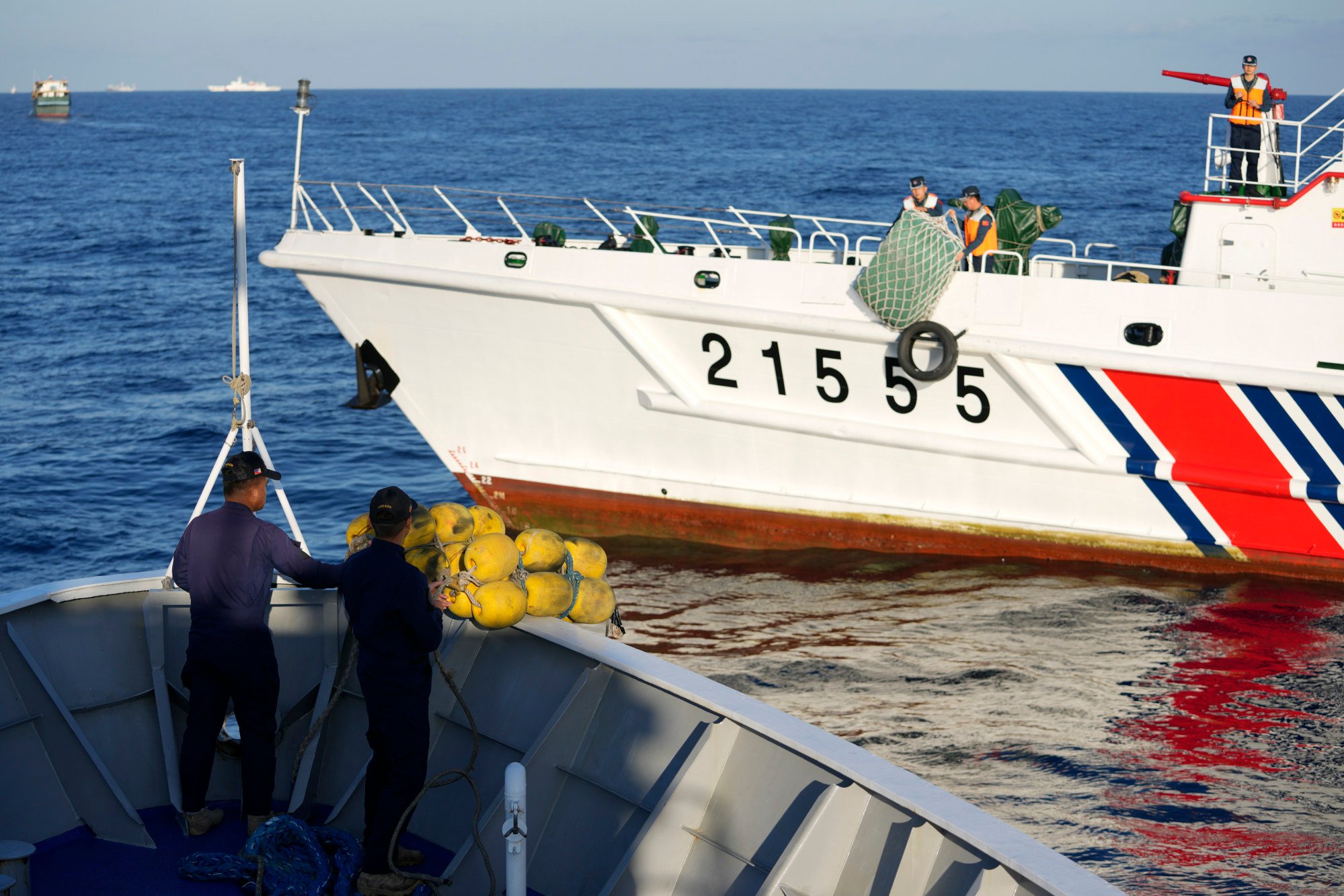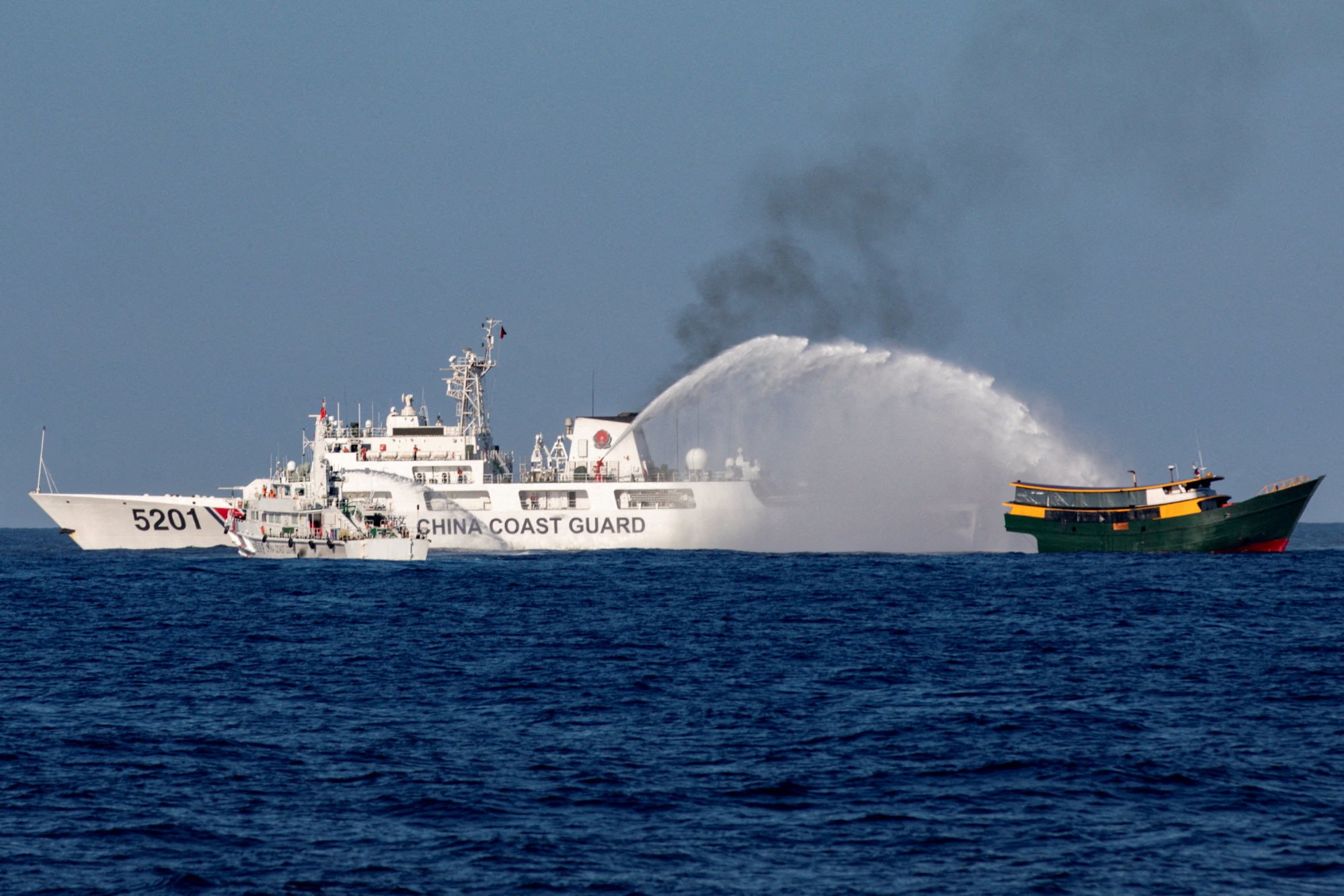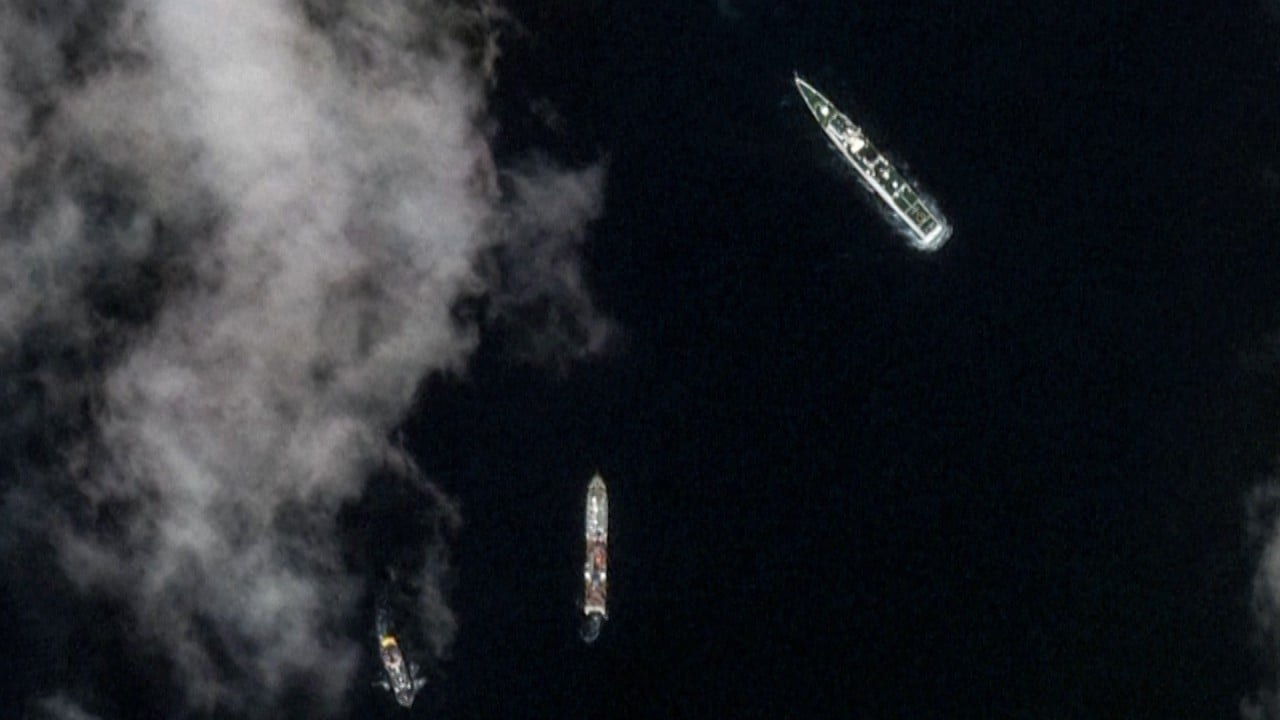
South China Sea: Philippines, US, Japan to step up maritime cooperation to deter Beijing’s aggression
- Joint statement by the three leaders makes it clear the Washington summit was aimed at opposing China’s recent maritime activities
- The three countries will hold maritime exercises to ‘improve interoperability’, and invest in high-impact infrastructure projects in the Philippines
The trilateral summit in Washington between the leaders of the Philippines, United States and Japan saw a number of announcements focused on strengthening maritime defence cooperation in the South China Sea to counter Beijing’s increasingly aggressive actions in the disputed waters.
Of particular interest to those in the Philippines was confirmation that the country’s coastguard would be included in Manila’s mutual defence treaty with the US, as well as a number of “high-impact infrastructure projects”.
The joint statement released by Philippine President Ferdinand Marcos Jnr, US President Joe Biden and Japanese Prime Minister Fumio Kishida at the conclusion of Thursday’s summit made it clear that the meeting was aimed at opposing Beijing’s recent maritime activities.

“We express our serious concerns about the People’s Republic of China’s dangerous and aggressive behaviour in the South China Sea,” the statement said. “We are also concerned by the militarisation of reclaimed features and unlawful maritime claims in the South China Sea.”
The statement also expressed “steadfast” opposition to “the dangerous and coercive use of Coast Guard and maritime militia vessels in the South China Sea”, a reference to Beijing’s strategy of using both military and paramilitary maritime forces.
In Beijing, foreign ministry spokeswoman Mao Ning said China “firmly opposes the relevant countries manipulating bloc politics, and firmly opposes any behaviour that provokes or lays plans for opposition, and hurts other countries’ strategic security and interests”.
Japan and the Philippines “should not invite factional opposition into the region, much less engage in trilateral cooperation at the cost of hurting another country’s interests”, Mao said, adding that China’s actions in the East and South China Seas “are appropriate and lawful, and beyond reproach”.
The summit leaders also reiterated “serious concern over [China’s] repeated obstruction of Philippine vessels’ exercise of high seas freedom of navigation and the disruption of supply lines to Second Thomas Shoal”.
The Second Thomas Shoal is a maritime landmark located within the West Philippine Sea – Manila’s term for the section of the South China Sea that lies within its exclusive economic zone.
In recent years, Chinese vessels have repeatedly attempted to disrupt resupply missions to troops stationed at the BRP Sierra Madre – a World War II era Philippine Navy vessel that was deliberately grounded on the shoal to strengthen Manila’s territorial claims to the surrounding waters – including through the use of high-pressure water cannons.

While in Washington, Marcos Jnr held a separate meeting with his US counterpart, after which he told the media: “President Biden reinforced the ironclad US alliance commitment to the Philippines under the US-Philippines Mutual Defence Treaty [MDT], which extends to armed attacks on Philippine armed forces, public vessels, or aircraft – to include those of its Coast Guard – in the Pacific, including anywhere in the South China Sea.”
The mention of the coastguard was seen as particularly significant since security analysts had earlier pointed out that the MDT does not explicitly apply to “armed attacks” on the coastguard, which has in recent months borne the brunt of water cannon attacks from Chinese coastguard vessels.
Biden also reiterated that “any attack on Philippine aircraft, vessels or armed forces in the South China Sea would invoke our mutual defence treaty”.
Why are Philippines-China tensions heating up and will US get involved?
The Chinese embassy in Manila said it was unimpressed by the summit’s mention of the MDT.
“China is determined to uphold our territorial sovereignty and maritime rights and interests. The [MDT] will not move us a bit from our will and resolve,” it said in a statement.
During the summit, the three countries said their respective coastguards would work closely together in the Indo-Pacific and hold joint exercises and other maritime activities to “improve interoperability”.
Asked if his organisation had been expecting the announcement of joint activities, Rear Admiral Armand Balilo, a Philippine Coast Guard spokesman, told This Week in Asia: “Yes, we have been in coordination with Japan and the US for interoperability exercises. In fact, we have invited them to join the exercise this June in western Visayas.”
He said the focus of the exercises was interoperability “in functions like search and rescue, law enforcement and environmental protection”.

Asked if such exercises and joint operations might escalate tensions with China, Balilo said, “I don’t think so. This is white-to-white ship engagement and focused on coastguard functions.”
At the summit, the three leaders also launched the “Luzon Economic Corridor” – named for the Philippines’ biggest island – which is meant to “support connectivity between Subic Bay, Clark, Manila and Batangas”. Subic and Clark are former American military bases – the biggest outside the continental US during the Cold War.
The three countries also said they would invest in “high-impact infrastructure projects, including rail; ports modernisation; clean energy and semiconductor supply chains and deployments; agribusiness and civilian port upgrades at Subic Bay”.
Duterte claims China threatened war over South China Sea if status quo not kept
Meanwhile, in an interview with the Chinese state-run news outlet Global Times published online on Thursday, former Philippine president Rodrigo Duterte criticised the close ties between his country and the US.
“So I am very sure of that – America is giving the instructions to the Philippine government to ‘not be afraid because we will back you up’,” he said.
“But I do not think that America will die for us. And yet, America has so many bases in the Philippines now; I objected to it when the US wanted to build a military base in the Philippines. Then, with the consent of the president of the Republic of the Philippines, they have so many bases.”
Duterte claimed that “there was no quarrel” during his time as president. “I hope that we can stop the ruckus over there, because the Americans are the ones pushing the Philippine government to go out there and find a quarrel and eventually maybe start a war,” he said.



